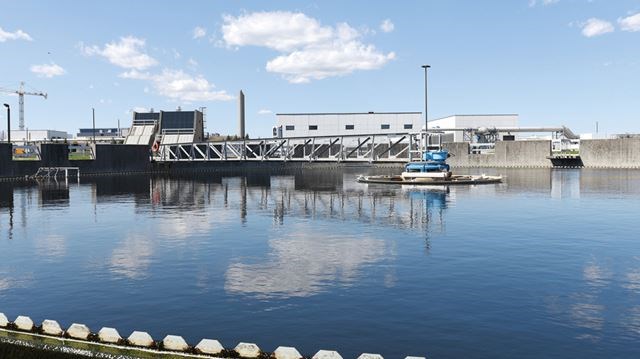Nutrient loadings (particularly phosphorus) from human, agricultural, and industrial waste, combined with climate change, changes in land use patterns, and invasive species are creating algal blooms in Ontario’s lakes. In some cases, the blooms involve blue-green algae, which can produce harmful toxins. There is no doubt that the rising trend of algal blooms across Ontario’s lakes needs to be addressed by more phosphorus controls.
To be prudent, the province of Ontario needs to focus on the greatest phosphorus reductions at the least cost when developing additional controls—not just financial, but also environmental, energy, and carbon costs. From this perspective, how do the increasingly stringent phosphorus effluent limits currently being applied to some Ontario wastewater treatment plants measure up?
Ontario’s wastewater discharge limits
Compared to other sources of phosphorus, wastewater treatment plants are relatively easy and convenient for the province to regulate and monitor. This is likely why wastewater plants have been the focal point of provincial phosphorus regulations even though non-point sources (i.e., farm and urban run-off) typically represent the lion’s share (approximately 90 per cent) of phosphorus loadings to Ontario’s lakes. An ECO report published in May 2017, Every Drop Counts, highlights the lopsided energy cost-to-environment benefit equation that can result from a single-minded focus on wastewater effluent phosphorus limits.
As a general rule, Ontario wastewater treatment plant effluent must not exceed a monthly average concentration of one milligram per litre (mg/L) of phosphorus. For some plants, the province sets more stringent effluent limits, as low as 0.02 mg/L, depending on the receiving water body, watershed-specific regulations or policies, and the municipality’s ability to fund the necessary treatment technologies.
As a result, wastewater facilities may require additional chemical inputs during secondary treatment (to increase coagulation), in addition to upgrading to tertiary treatment, and in some limited instances, quaternary treatment. Phosphorus effluent concentrations typically achievable with different levels of treatment, and their relative energy intensity.
High cost for little benefit?
Reducing phosphorus effluent concentrations at wastewater treatment plants to minuscule levels is not always good public policy. For little environmental benefit, these caps will disproportionately drive up associated costs, as a result of additional energy requirements and (in some cases) chemical inputs.
For example, in order to meet its phosphorus concentration limit of 0.03 mg/L, the Midhurst Wastewater Treatment Plant in Simcoe County, Ont. is proposing energy intensive advanced tertiary treatment, via membrane filtration, in combination with additional chemical coagulation in the secondary treatment phase.
To meet its 0.02 mg/L limit, York Region’s new wastewater facility under development, Upper York Sewage Solutions, has proposed the use of reverse osmosis technology. This technology, which is also used to desalinate seawater, requires a substantial amount of electricity to pressurize wastewater through a very fine filter. With this technology, the cost of removing a kilogram of phosphorus from wastewater effluent jumps from about $45,000 per kilogram at tertiary treatment levels, to $100,000 per kilogram at quaternary treatment levels.

A significant part of the increased costs is due to the additional energy use required by these systems, which can use as much as five times more energy. According to York Region, their newest wastewater treatment plant will require 3,000 kilowatt hours of electricity per million litres treated. For comparison, the Duffin Creek Water Pollution Control Plant, which currently treats the majority of York Region’s wastewater and discharges into Lake Ontario, has an energy intensity of approximately 500 kilowatt hours per million litres.
The additional energy used for advanced wastewater treatment is primarily electricity. It is true that 90 per cent of Ontario’s electricity generation has low greenhouse gas (GHG) emissions. But importantly, electricity used at peak times of day and peak seasons may be gas-fired. Gas-fired electricity produces about five megatonnes of Ontario’s GHG emissions each year (about three per cent of total emissions).
Or less cost for more benefit?
In contrast, removing a kilogram of phosphorus from non-point sources costs much less (estimates range from $4 – $1,700), with little-to-no energy consumption, GHGs, or other associated environmental impacts.

ECO’s latest Environmental Protection Report, Good Choices, Bad Choices, discusses a variety of non-point source strategies to complement point-source limits, namely: phosphorus trading, targeted funding for on-farm phosphorus controls, banning spreading farm manures and fertilizers on frozen or saturated ground, and better-protecting wetlands. Phosphorus trading (or offsetting) in particular enables a municipality or a wastewater treatment plant to achieve its effluent limits at the lowest costs. This type of program has proved effective in eastern Ontario’s South Nation Conservation region since 1998. The key is effective monitoring and verification protocols.
Increasingly stringent phosphorus reductions are necessary as populations grow around stressed waterbodies. But why spend $100,000 removing one kilogram of phosphorus from wastewater effluent, if the same money could reduce 50-to-250 kilograms of phosphorus from non-point sources discharging into the same lake?
As we recommended in the report Every Drop Counts, the Ministry of the Environment and Climate Change should implement phosphorus reduction programs that reduce loadings to sensitive surface waters, in a way that minimizes the energy use, financial costs, and greenhouse gas emissions needed to achieve reductions.
Dianne Saxe is the Environmental Commissioner of Ontario.
The full report, Every Drop Counts, is available online.











